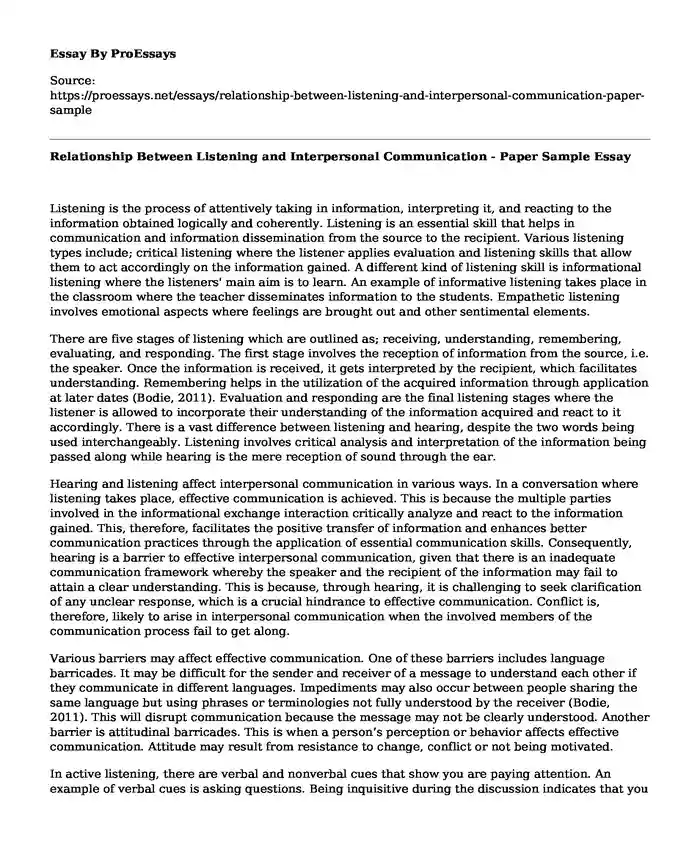Listening is the process of attentively taking in information, interpreting it, and reacting to the information obtained logically and coherently. Listening is an essential skill that helps in communication and information dissemination from the source to the recipient. Various listening types include; critical listening where the listener applies evaluation and listening skills that allow them to act accordingly on the information gained. A different kind of listening skill is informational listening where the listeners' main aim is to learn. An example of informative listening takes place in the classroom where the teacher disseminates information to the students. Empathetic listening involves emotional aspects where feelings are brought out and other sentimental elements.
There are five stages of listening which are outlined as; receiving, understanding, remembering, evaluating, and responding. The first stage involves the reception of information from the source, i.e. the speaker. Once the information is received, it gets interpreted by the recipient, which facilitates understanding. Remembering helps in the utilization of the acquired information through application at later dates (Bodie, 2011). Evaluation and responding are the final listening stages where the listener is allowed to incorporate their understanding of the information acquired and react to it accordingly. There is a vast difference between listening and hearing, despite the two words being used interchangeably. Listening involves critical analysis and interpretation of the information being passed along while hearing is the mere reception of sound through the ear.
Hearing and listening affect interpersonal communication in various ways. In a conversation where listening takes place, effective communication is achieved. This is because the multiple parties involved in the informational exchange interaction critically analyze and react to the information gained. This, therefore, facilitates the positive transfer of information and enhances better communication practices through the application of essential communication skills. Consequently, hearing is a barrier to effective interpersonal communication, given that there is an inadequate communication framework whereby the speaker and the recipient of the information may fail to attain a clear understanding. This is because, through hearing, it is challenging to seek clarification of any unclear response, which is a crucial hindrance to effective communication. Conflict is, therefore, likely to arise in interpersonal communication when the involved members of the communication process fail to get along.
Various barriers may affect effective communication. One of these barriers includes language barricades. It may be difficult for the sender and receiver of a message to understand each other if they communicate in different languages. Impediments may also occur between people sharing the same language but using phrases or terminologies not fully understood by the receiver (Bodie, 2011). This will disrupt communication because the message may not be clearly understood. Another barrier is attitudinal barricades. This is when a person’s perception or behavior affects effective communication. Attitude may result from resistance to change, conflict or not being motivated.
In active listening, there are verbal and nonverbal cues that show you are paying attention. An example of verbal cues is asking questions. Being inquisitive during the discussion indicates that you are paying attention, and are serious about the topic. Another verbal cue is paraphrasing (Armstrong & Rubin, 2019). Doing this shows that the point was understood and you can put it in your own words. Clarifying an issue that was not well understood is also another verbal cue that shows interest in the topic of discussion. Nonverbal cues include maintaining eye contact. Pairing eye contact with an occasional smile encourages the speaker. A person’s posture also shows their level of attention. An upright posture or leaning forward indicates that you are paying attention. The gestures and body language you use also show your level of listening. Nodding your head is an example of a gesture that shows active communication. In conclusion, communication is a flow of information from a sender to a recipient that has stages and barriers that may affect the message.
References
Bodie, G. D. (2011). The understudied nature of listening in interpersonal communication: Introduction to a particular issue. The Intl. Journal of Listening, 25(1-2), 1-9.
Armstrong, C. B., & Rubin, A. M. (2019). Talk radio as interpersonal communication. Journal of Communication, 39(2), 84-94.
Cite this page
Relationship Between Listening and Interpersonal Communication - Paper Sample. (2024, Jan 10). Retrieved from https://proessays.net/essays/relationship-between-listening-and-interpersonal-communication-paper-sample
If you are the original author of this essay and no longer wish to have it published on the ProEssays website, please click below to request its removal:
- The Impact of Social Media on the Society Essay
- Families and Children's Services of Frontenac - Essay Sample
- Essay Sample on the Five Stages of Grief an Examination of the Kubler-Ross Model
- Essay Sample on Diversity Consciousness
- Paper Example on Social Inequality at California State University
- Paper Sample on Building Confidence in the Workplace: Courage, Training & Self-Esteem
- Paper Example on Age-Related Changes: Nutritional Challenges & Health Risks







